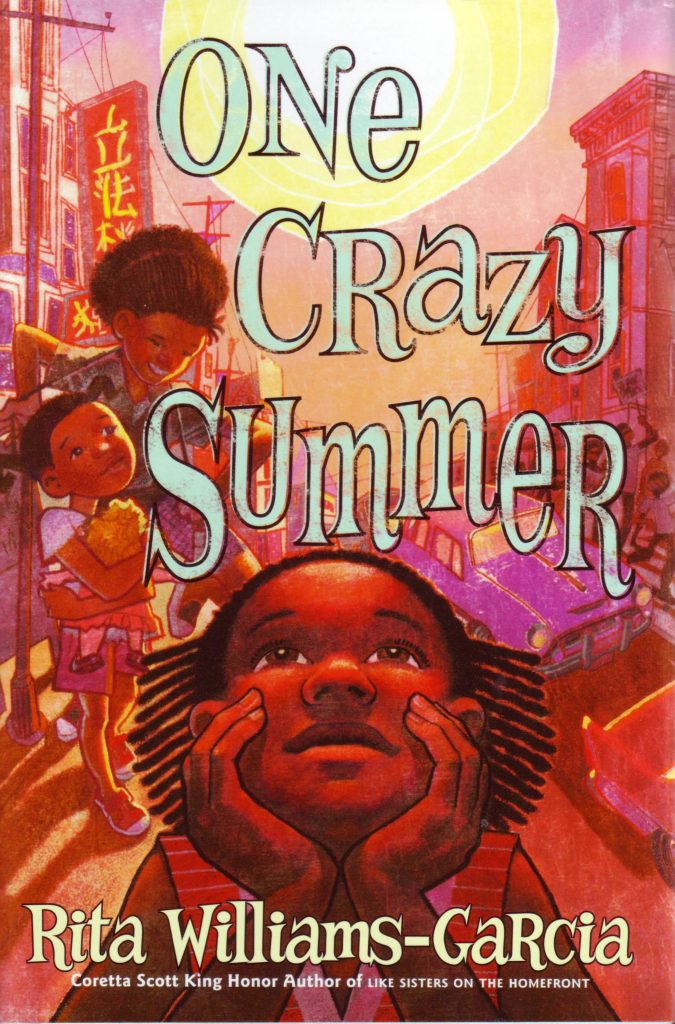by Michelle Grace Williams and Julia López-Robertson, University of South Carolina
.
The most educators can do is to create structures that would enable submerged voices to emerge. It is not a gift. Voice is a human right. It is a democratic right. (Macedo, 2006.p. 4)
.
.
In our first blog last week, we explained that the goal for all of our blogs is to discuss texts that could be used in the classroom to validate the experiences of Black children; children of the African Diaspora, children of African ancestry located in America, the Americas and other parts of the world. This week, we examine the book One Crazy Summer by Rita Williams-Garcia.
Set in Oakland, California in 1968 during a tumultuous period in American history, the book details how three young Black sisters; Delphine, Fern and Vonetta travel from Brooklyn to visit their estranged mother and become critically conscious (Freire, 1970) of the world around them and their place in it. The sisters became critically aware, for example, of the role of the Black Panthers in challenging social injustice and how poems written and performed by them can be used as sites for resistance.
Early on in their summer vacation, the girls became suspicious about the on-goings at Cecile’s [their mother] house and draw on their spy skills to find out what is going on: “Once again, we fell into our spying positions, angling ourselves at the cracked door to see, while pressing our ears against the air”. Later Delphine, who heard her father and grandmother speak of the Black Panthers in Brooklyn, states: “I was sure they were Black Panthers. They were on the news a lot lately. The Panthers on TV said they were in communities to protect poor black people from the powerful; to provide things like food, clothing, and medical help; and to fight racism” (p. 3 of 8 in ‘For the people’).
In reciting their mother’s poem I Birthed a Black Nation (excerpted below) which spoke about Black struggles and resilience, the girls’ voices merged with hers to create a quilted counter story (Yosso & Solórzano, 2009) that challenged the oppressive forces in society.
I birthed a black nation
From my womb black creation
Spilled forth
To be
Stolen
Shackled
Dispersed.
I dispatched black warriors
Raged against unjust barriers
To find the
Black and strong had fallen
Divided
Deceived
Overcome.
Black oceans separate us
Tortured cries
Songs
Of black greatness
Still echo in my canal
Hear the reverberation
Of a stolen black nation
Forever lost
To foreign shores
Where thieves do not atone
And Mother Africa cannot be consoled
Culturally Relevant Teaching
The sisters were exposed to culturally relevant teaching at the Community School as race and culture were placed at the center of their teacher’s discourse (Gay, 2010). Culturally relevant teaching refers to the use of “ cultural knowledge, prior experiences, frames of reference, and performance styles of ethnically diverse students to make learning encounters more relevant to and effective for them (Gay, 2010, p.31). In addition the sisters were given the opportunity to maintain their cultural competence (Ladson-Billings, 2009) because culturally knowledgeable others (Vygotsky, 1978) from the Black Community were engaged in their learning activities. During their daily classroom activities they interacted with culturally relevant texts such as the poem We Real Cool by Gwendolyn Brooks which empowered the sisters as readers because they were not treated as “invisible eavesdroppers” (Rosenblatt, 1994, p. 2) in the text but as readers who brought something to the text.
Rita Williams-Garcia skillful manipulation of socio-cultural and historical details about African American experiences in her book, One Crazy Summer, makes it a useful resource for helping Black students become more critically conscious of the world in which they live. What kinds of texts can you bring in the classroom that could help your students find their voice and use it to critique things that they consider to be unfair in the society? How might you engage members of their community in this process?
References
Freire, P. (1970). Pedagogy of the oppressed. (30th ann.ed.). New York: Continuum.
Gay, G. (2010). Culturally responsive teaching: Theory, research, and practice (2nd ed.). New York, NY: Teachers College Press.
Ladson-Billing, G. (2009). Foundations of critical race theory in education. In E. Taylor, D. Gillborn, & G. Ladson-Billings (Eds.), Foundations of critical race theory in education (pp.17-36). New York: Routledge.
Macedo, D. (2006). Literacies of power: What Americans are not allowed to know. Boulder, CO: Westview.
Rosenblatt, L. The reader, the text, the poem: The Transactional theory of the literary work. IL: Southern Illinois University Press.
Solórzano, D. & Yosso, T. (2009). Critical race methodology: Counter-Story telling as an analytical framework for educational research. In E. Taylor, D. Gillborn & G. Ladson-Billings, Foundations of critical race theory in education (pp.131-147). New York, NY: Rouledge.
Vygotsky, L. (1978). Mind in society: The development of higher psychological processes. Cambridge, MA: Harvard University Press.
Journey through Worlds of Words during our open reading hours: Monday-Friday, 9 a.m. to 5 p.m. and Saturday, 9 a.m. to 1 p.m. To view our complete offerings of WOW Currents, please visit archival stream.
- Themes: Julia López-Robertson, Michelle Grace-Williams, One Crazy Summer
- Descriptors: Books & Resources, Student Connections, WOW Currents

